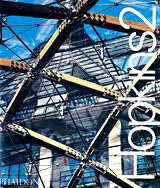Hopkins2 and Foster

Hopkins2 is the second monograph on Michael Hopkins and Partners, designed by Simon Esterson and published by Phaidon, and Sir Norman Foster is published by Taschen, with a layout by Sylvie Chesnay.
Taschen is a strange fish. Its books are always cheap, with fabulous print quality, but they never seem to be about anything. I always wonder if it designs them purely to look good at postage stamp size in its sales catalogue, and then resent the slog of actually producing a book. On inspection the gobbledygook multiple-language text never has a thesis; the books dissolve into mere collections of pictures. The form of this one is typical: a scant introductory essay, followed by equally minimal project profiles with a couple of pictures.
As a sign of how accurate this book is, the title Sir Norman Foster is wrong: Foster has been The Lord Foster of Thameside for two years. You can sympathise with the publisher’s confusion over the fine detail of Britain’s Imperial nomenclature, but anyone even vaguely interested in architecture will know that determined self-improvement and discipline is an essential part of the Foster myth. Anyone looking for evidence needs only to consider the elocution lessons, the plane, helicopter and pilot’s license, the elegant wives, the steady elevation from Mancunian urchin to Lord of the realm.
Hopkins2 is not wholly different, but Simon Esterson is not new to this game. He has designed countless magazines and books about architecture. In this book analytical essays by big name critics wrap around descriptions of the projects, that take as many pages as they need to describe each complex project. Lots of huge pictures, lots of sequenced pictures showing buildings going up and lots of pictures juxtaposed with exploded drawings as a way of showing the skin and bones of the building simultaneously.
The design manages to be both assymmetric and accessible. Nice big type, ruthlessly clean pages with no sketches or little pictures sprinkled on to them to make them ‘more interesting’, and a logical relationship between captions and pictures (so often with picture books one spends a minute or two trying to find the caption for a picture, and then decoding its short lines).
The book wins my blue riband for its understated, airy and unpretentious role as mediator between me and Hopkins’ way of making buildings.
Sir Norman Foster by Philip Jodidio is published by Taschen and priced at £16.99. Hopkins2, with essays by Colin Davies, Charles Jencks, Patrick Hodgkinson and Paul Finch is published by Phaidon and is priced at £45
-
Post a comment




